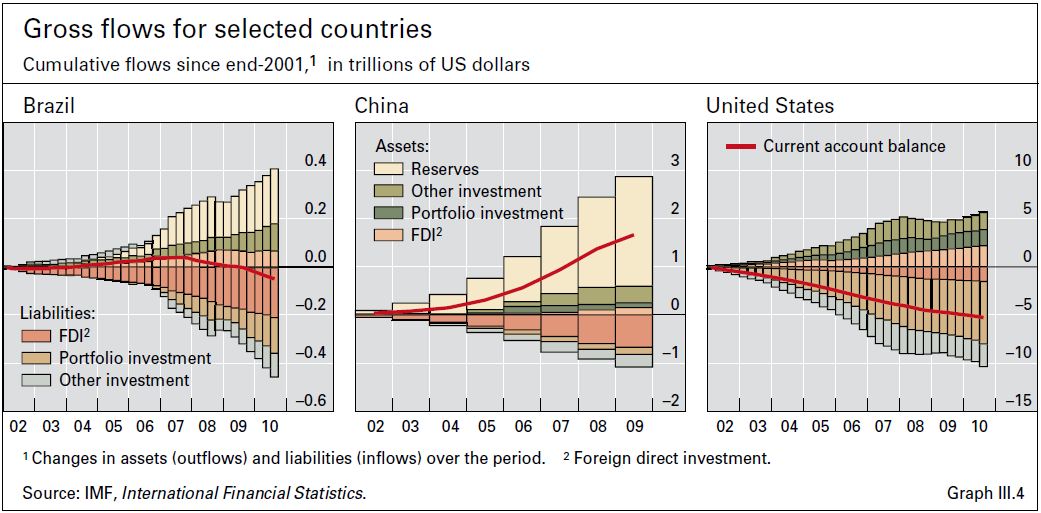Now comes the Annual Report of the Bank for International Settlements, one of the few official agencies to raise alarm about potential crisis before the actual crisis occurred. As I read their Report, they are raising alarm once again. We should pay attention.
The first thing to be said is that this is a wonderfully comprehensive report, pulling together a vast amount of data and using it to paint a genuinely global picture of the state of monetary matters. I have in previous posts attempted to sketch my own guess about the overall picture, but these guys have the data, and they (some of them anyway) also have a money view that informs their interpretation of the data.

BIS Annual Report 2010/11, p. 42
Most important, in this respect, is their emphasis on the importance of gross financial flows (and the resulting accumulated exposures) across borders, rather than the net current account balance. The picture above shows what we know about those flows, but that is only what the existing statistical net captures. Financial globalization has left our existing statistical net behind.
The second thing to be said about the Report is that not all of the pieces yet fit together, and there are clear signs of competing interpretations among those who put the Report together. Like me, the authors are writing the history of events still in progress, and are keenly aware that multiple futures are possible.
The future that most worries them, throughout the Report, is a possible repeat of the credit bubble that produced the financial crisis of 2007-2009, this time in the emerging market economies rather than the United States. More or less the same global imbalances remain as the underlying fuel, but this time extreme monetary ease in the US and UK is also adding to the problem. Asset price inflation and commodity price inflation, already evident in the data, are unfortunately only contemporaneous indicators of the problem. The magnitude of the potential danger would show up best in gross financial flows, and the consequent buildup of balance sheet mismatch exposures at a global level, but unfortunately our statistical net is poorly designed to capture these numbers. It might be happening again, right under our noses, but without us being able to see it until too late.
The prospect of another crisis is especially worrisome, so they suggest, because the system is not yet recovered from the last one. Most important, excessive debt burdens remain, in both private and public sectors. “Crisis-related expansions of sovereign debt have worsened what were already unsustainable fiscal policy trajectories, and private sector debt remains too high. The result is that, today, policymakers and households have virtually no room for manoeuvre.” (p. 1) “Since the government acts like an insurance company, it needs a reserve fund. This means that running a cyclical balance, in which budget surpluses in booms neutralise budget deficits in recessions, is not good enough.” (p. 11)
The fiscal consolidation the BIS recommends is obviously tough medicine for the advanced countries, already stuck in the low-speed lane of the two-speed global recovery, so it is important to emphasize their underlying rationale. It is NOT that government has been profligate and now needs to tighten its belt! Rather, the argument is that the US, and other countries as well, have during the boom over-invested in the construction and finance sectors of the economy, to the detriment of other sectors. Return to growth will happen only when that misallocation is fixed.
“For the advanced countries that were most affected by the crisis, undue delay in the normalisation of the monetary policy stance entails the risk of creating serious financial market distortions, the postponement of deleveraging and the misallocation of resources. Moreover, the unusually accommodative monetary conditions in advanced economies have probably been an important factor behind the recent large capital flows to emerging market economies.” (p. 62)
Translated into English, what this quote means is that the advanced countries are using monetary policy to avoid necessary adjustment, and in doing so they are not only delaying their own recovery but also threatening the rest of the world with a repeat bubble. The mechanism of that repeat bubble, so the authors suggest, is the carry trade—borrowing in the low rate advanced countries and lending in the high rate emerging market economies. The mechanism of the potential collapse is the growing risk exposure involved in that trade: mainly interest rate risk, foreign exchange risk, and counterparty risk.
But this is only one scenario in the Report. Alternatively, it is also suggested that the implementation of Basel III will come in time, and will work to force reduction in risk exposures. That’s the hope. How much of a hope is it? I leave you with a final quote from the Report:
“In an ideal world, policymakers would have a unified theoretical framework for identifying and quantifying systemic risk. Such a framework would capture all key drivers of systemic risk, such as market structure, institutional incentives, risk (mis)measurement and market participants’ reactions to events. But no such framework exists.”
Translation: new economic thinking is needed.





